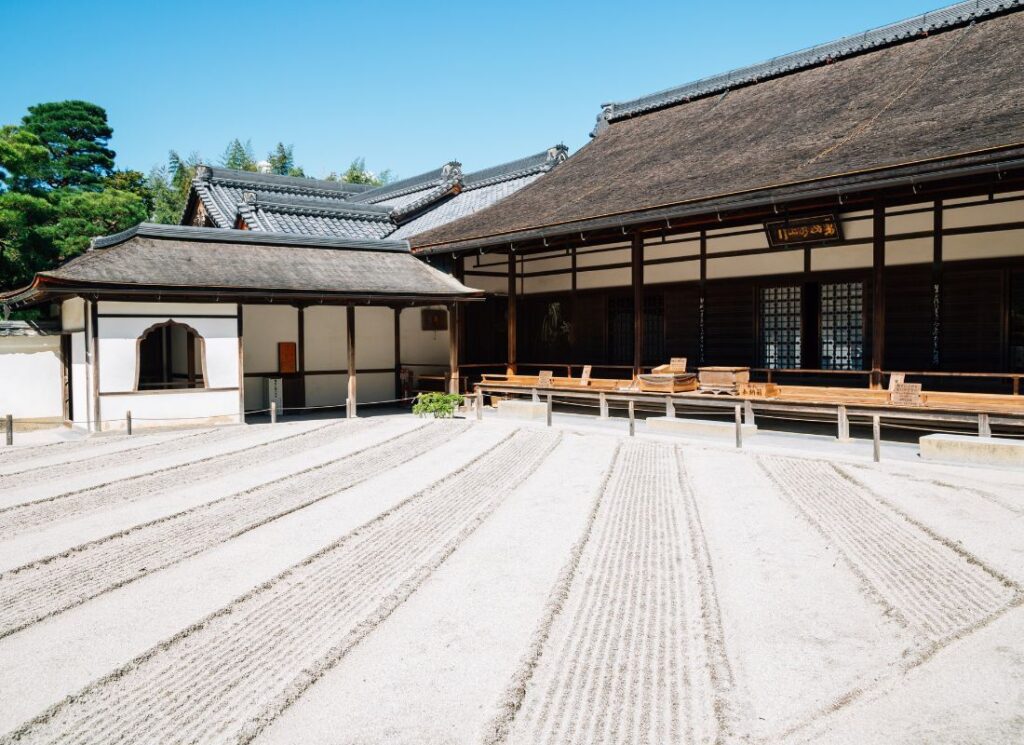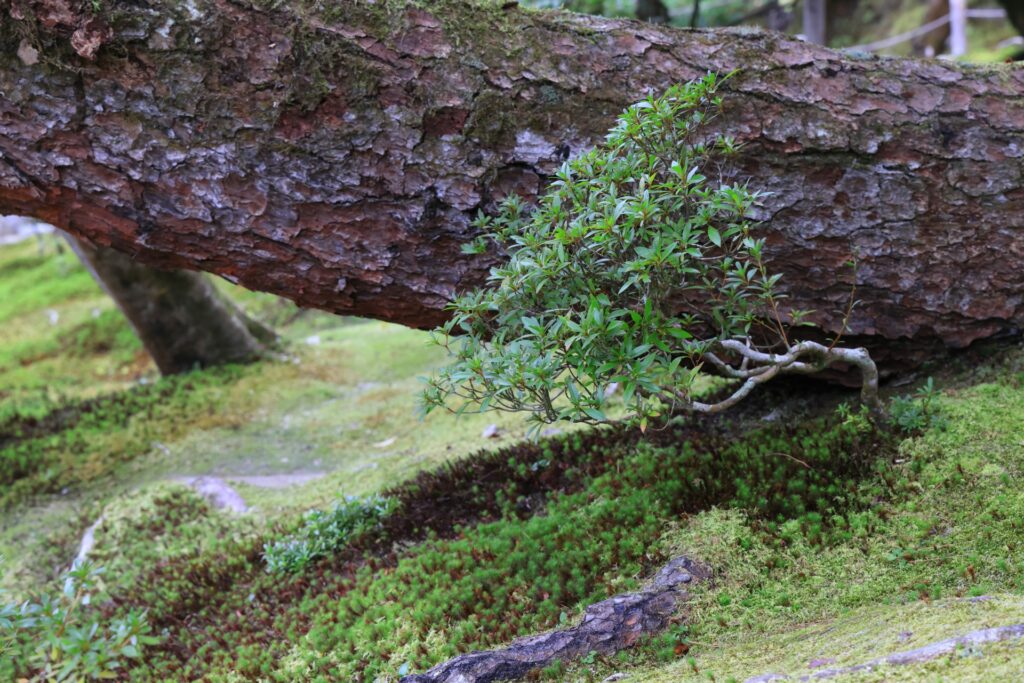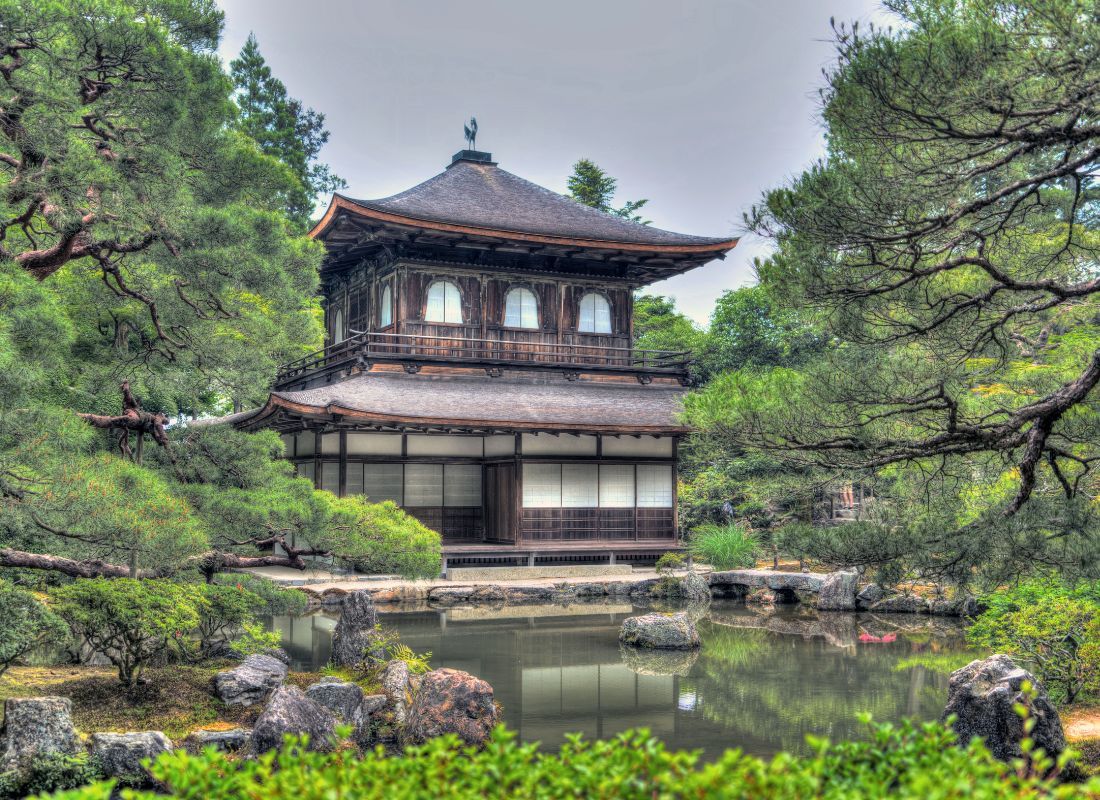Ginkakuji, also known as the Silver Pavilion, is a Zen temple located in the eastern mountains of Kyoto’s Higashiyama district. Built-in 1482 by shogun Ashikaga Yoshimasa as a retirement villa, it was later converted into a temple after his death.
The temple is known for its stunning architecture and beautiful gardens and is well worth a visit.

The temple’s main building, the Silver Pavilion, is a masterpiece of Japanese architecture and is covered in silver leaf, which gives it a beautiful, shimmering appearance. We also enjoy exploring the temple’s beautiful gardens, which feature a great mix of trees, plants, and flowers, as well as a sand garden and a moss garden.
Ginkakuji, although not as well known as its more famous cross-town rival Kinkakuji (Goldin Pavilion) is in many ways a more rewarding experience to visit.
History of Ginkakuji

Ginkakuji is a Zen temple located in the Sakyo ward of Kyoto, Japan, and was built by Ashikaga Yoshimasa, the eighth shogun of the Ashikaga shogunate, in 1482 as a retirement villa. Yoshimasa intended to cover the villa with silver leaf, but due to financial difficulties, he was unable to do so. The villa was converted into a temple after Yoshimasa’s death in 1490.
The temple’s official name is Jisho-ji, but it is commonly referred to as Ginkakuji due to its association with the Silver Pavilion. The temple is a UNESCO World Heritage Site and is considered one of the most important cultural landmarks in Japan.
Ginkakuji was heavily damaged during the Onin War in the 15th century, and it was later restored by the famous Japanese tea master, Sen no Rikyu, in the 16th century. The temple has undergone several renovations and reconstructions over the centuries, including a major restoration project in the 20th century.
Today, Ginkakuji is a popular destination and a symbol of Kyoto’s rich cultural heritage. The temple’s beautiful gardens, traditional architecture, and serene atmosphere attract visitors from around the world.
Ginkakuji is one of the most important examples of the Higashiyama culture, a period of cultural and artistic flourishing that occurred in Japan during the 15th and 16th centuries. The temple’s design and architecture reflect the aesthetic values of this period, which emphasized simplicity, elegance, and natural beauty.
Ginkakuji’s Architecture

Ginkakuji is a stunning example of Japanese temple architecture from the Muromachi era (1338-1573). The temple complex is designed to harmonize with the natural surroundings and features a mix of traditional Japanese and Chinese architectural styles.
The main building of Ginkakuji is the Silver Pavilion, a two-story structure that was originally intended to be covered in silver leaf, hence its name.
Unfortunately, the shogun who commissioned the pavilion ran out of money before the silver could be applied, so the building was left with its natural wood finish. The Silver Pavilion is surrounded by a beautiful garden, which includes a sand garden and a pond.
Another notable building at Ginkakuji is the Togudo, a small structure that was used for meditation. The Togudo features a thatched roof and is built entirely out of wood, with no nails used in its construction. The building is surrounded by a small garden and is accessible via a long, narrow path that winds through the trees.
One of the interesting facets of Ginkakuji’s architecture is the use of shakkei, or “borrowed scenery.” This technique involves incorporating the natural surroundings into the design of the temple complex, creating a sense of harmony between the man-made structures and the natural environment.
The surrounding mountains and trees are visible from many points within the temple complex, creating a beautiful and serene atmosphere.
The design of Ginkakuji has had a significant influence on Japanese temple architecture, particularly in the use of shakkei and the incorporation of natural elements into the design of the temple complex.
Ginkakuji’s Garden

The garden at Ginkakuji is a beautiful and serene space that perfectly complements the temple’s minimalist aesthetic. The garden is divided into two parts: the moss garden and the sand garden.
The moss garden is a beautiful, green space that is filled with various types of moss and is meant to represent a river.

Visitors can walk along a path that winds through the garden, taking in the peaceful atmosphere and admiring the carefully arranged rocks and trees.
The sand garden, on the other hand, is a dry garden that is meant to represent the ocean. It is made up of carefully raked sand and a few carefully placed rocks. Visitors can sit and contemplate the garden, taking in the carefully arranged patterns in the sand and the way the rocks are arranged.

The garden is also home to a number of beautiful cherry blossom trees, which bloom in the spring and attract many visitors. The garden is especially beautiful in the autumn, when the leaves on the trees change color and the garden is bathed in a warm, golden light.
Overall, the garden at Ginkakuji is a beautiful and peaceful space that perfectly complements the temple’s minimalist aesthetic. you can spend hours wandering through the garden, taking in the carefully arranged rocks and trees, and contemplating the beauty of nature.
Tea Ceremony at Ginkakuji
One of the must-do activities when visiting Ginkakuji is participating in a traditional Japanese tea ceremony. The tea ceremony has a long history in Japan and is considered a cultural treasure. It is a ritualized way of preparing and serving tea to guests, which involves a series of precise movements and gestures.
There are several places near Ginkakuji where visitors can experience a tea ceremony. One of the most popular is Gen-an, a traditional Tea-Room located just a 2-minute walk from Ginkakuji.
They offer a unique and authentic tea ceremony experience that includes a brief introduction to the history and philosophy of the ceremony, as well as the opportunity to make your own tea.
Another option is Tea Ceremony Koto, which is located right by Kinkakuji. A Tea Ceremony here provides the chance to not only experience a Japanese tea ceremony but employ fully licensed, fluent English-speaking tea masters to guide you through the ceremony. They offer several different packages to choose from, including matcha and sweets sets.
Whichever tea ceremony experience you choose, be prepared to sit on the floor in a tatami room and follow the instructions of the tea master. It is a peaceful and meditative experience that will leave you feeling relaxed and refreshed.
How to Get to Ginkakuji Temple in Kyoto

Ginkakuji Temple, also known as the Silver Pavilion, is a popular tourist attraction in Kyoto. Here are some ways to get to Ginkakuji:
By Subway and Bus

The easiest way to get to Ginkakuji from Kyoto Station is by taking the subway and then transferring to a bus. Follow these steps:
- Take the Karasuma Line subway from Kyoto Station to Kitaoji Station (about 10 minutes).
- Transfer to the #5 bus bound for Ginkakuji Temple at the Kitaoji Bus Terminal (about 30 minutes).
- Get off at the Ginkakuji-michi bus stop.
- Walk about 5 minutes to the temple.
By Raku Bus
You can also take the Raku Bus 100 from Kyoto Station to Ginkakuji-mae bus stop. This bus is a sightseeing bus that stops at many popular attractions in Kyoto, including Ginkakuji. The bus ride takes about 45 minutes, and then it’s a six-minute walk to the temple.
By Taxi
If you prefer a more direct and comfortable option, you can take a taxi from Kyoto Station to Ginkakuji. The ride takes about 20-30 minutes, depending on traffic. However, this option can be expensive.
Overall, getting to Ginkakuji Temple is relatively easy and straightforward, and enjoy exploring this beautiful temple.





